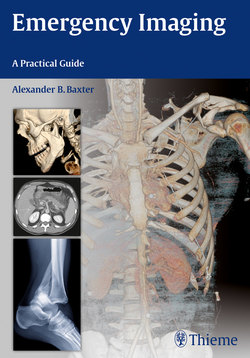Читать книгу Emergency Imaging - Alexander B. Baxter - Страница 105
На сайте Литреса книга снята с продажи.
Оглавление93
3 Head and Neck
deformity. CT findings include fracture through the vomer or perpendicular eth-moid plate, and swollen paraseptal soft tis-sues. Treatment for significantly displaced septal fractures is surgical.
Naso-orbito-ethmoid (NOE) fractures are complex fractures of the nasal bones and the upper central mid-face due to di-rect impact to the nasal bridge. Fragments of the nasal bones, ethmoid air cells, and medial orbital walls are compressed and displaced posteriorly toward the sphenoid sinus. Cribriform plate and ethmoid roof fractures, when present, can be associated with anosmia, pneumocephalus, or CSF leak. Comminution and lateral displace-ment of the lacrimal bone can result in oc-ular, nasolacrimal duct, or nasofrontal duct injury. The medial canthal ligament, which anchors the globe, can be disrupted, with consequent enophthalmos, telecanthus, or ptosis. Traumatic nasolacrimal duct ob-struction may require surgical repair.
CT scans should include reformations in three planes, with particular attention to the nasolacrimal ducts, attachment of the medial canthal ligament, and integrity of the anterior skull base. Three-dimensional reformations are valuable for surgical plan-ning (Fig. 3.3).
◆ Nasal and Naso-Orbito-Ethmoid Fracture
Nasal fractures result from direct impact, and deformity, laceration, or ecchymosis are often evident on examination. Epistax-is and CSF rhinorrhea indicate potentially severe injuries to the ethmoid bones or na-sal septum.
Plain radiographs are rarely helpful. At best, they serve to document the presence of a fracture. If there is clinical concern for septal fracture or adjacent facial bone inju-ry, or if operative reduction is planned, CT scanning is preferred and provides more comprehensive evaluation. Nasal fractures are often detected when CT is obtained for more severe injuries, and they often make up a part of a larger facial fracture complex. Most are oriented perpendicular to the na-sal bridge, cross the nasomaxillary suture, and traverse the groove for the nasociliary nerve.
Because most simple nasal bone frac-tures are managed conservatively, clinical examination should include a search for septal deformity or hematoma. Although not specific for fracture, nasal septal hema-tomas are associated with significant mor-bidity and may lead to septal perforation or necrosis if untreated. Other consequences of failing to recognize a septal fracture are delayed nasal obstruction and cosmetic
Fig. 3.3a–fa Nasal bone fracture. Minimally depressed right nasal bone fracture. The nasal septum and turbinates are normal.
b Nasal septal fracture. Osseous septal fracture without associated hematoma. Bilateral minimally dis-placed nasal bone fractures.
c,d Nasal septal fracture with hematoma. Anterior septal soft tissue thickening. Osseous septal fracture. e,f Naso-orbital-ethmoid fracture. Severely comminuted nasal, ethmoid, and bilateral medial orbital wall fractures, with posterior telescoping of the ethmoid fragments. Left ethmoid and orbital roof frac-tures. Extensive facial soft tissue swelling with associated bilateral intraorbital hematomas.
